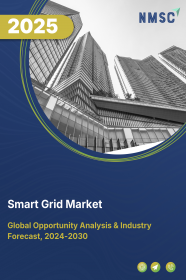
Smart Grid Market Smart Grid Market by Component (Services and Solution), by Application (Generation, Transmission, Distribution, and Consumption/End Use), by End User (Residential, Commercial, and Industrial) - Global Opportunity Analysis and Industry Forecast, 2021 – 2030 - Global Opportunity Analysis and Industry Forecast, 2021 – 2030
US Tariff Impact on Smart Grid Market
Trump Tariffs Are Reshaping Global Business
Market Definition
The global Smart Grid Market size was valued at USD 62.09 billion in 2020 and is predicted to reach USD 248.63 billion by 2030, with a CAGR of 15.2% from 2021-2030.
Smart grid holds wide applications in residential, commercial, and industrial sector, owing to their capability to ensure uninterrupted power supply by detecting and simultaneously restoring the faults in electricity supply chain. Smart grid comprises of smart appliances, smart meters, as well as energy efficient and renewable resources that assist in production, distribution, and conditioning of power in the entire supply chain, along with providing an integrated networking & communication system.
The benefits offered by smart grid such as, higher efficiency, energy conservation, uninterrupted power supply, minimal fluctuations in supply chain, reduced footprints, and most importantly environmental protection; consequently result to higher adoption of smart grid solutions; thereby propagating the growth of global smart grid market throughout the forecast period.
Market Dynamics and Trends
The global smart grid market witnessed a substantial growth in the past few years, and is expected to observe several lucrative opportunities for growth in coming future. The major driving factors in the global market are: development of smart cities, advancements in digital network infrastructures, increasing adoption of e-vehicles, higher penetration of AI, IoT, automation and robotics technologies, as well as favorable regulatory policies promoting the utilization of smart meters.
However, concerns regarding safety & security, standardization issues, and high maintenance costs, are expected to hinder the global market growth during the forecast period. Moreover, rapid industrialization, growing urbanization, increasing number of educational institutes, and growing commercialization with increasing number of malls, hypermarkets, and supermarkets, lead to higher demand of seamless power supply that augments the need of smart electric supply solutions. This scenario is expected to create new avenues for growth in the global market.
Market Segmentations and Scope of the Study
The global smart grid market share has been analyzed based on component, application, end user and geography. Based on component, the market is segmented into services and solution. The solution segment is sub segmented into Advanced Metering Infrastructure (AMI), Smart Grid Distribution Management, Smart Grid Communications, Smart Grid Network Management, Substation Automation, Smart Grid Security, and others. Based on application, the market is fragmented into generation, transmission, distribution, and consumption/end use. Based on end user, the global market is divided into commercial, residential, and industrial. Geographic breakdown and analysis of each of the previously mentioned segments include regions comprising Asia-Pacific, North America, Europe, and RoW.
Geographical Analysis
North America dominated the global smart grid market and is expected to maintain its dominance throughout the forecast period. This is due to well-established network infrastructures, increasing number of smart cities, and higher adoption of electric vehicles in this region.
Asia Pacific is expected to grow with the highest CAGR values in the global market throughout the forecast period, owing to increasing government initiatives to digitally transform the infrastructures and emerging concept of smart cities in this region.
Competitive Landscape
The smart grid industry is highly competitive and consists of various market players. Some of the major market players include ABB Ltd., Siemens AG, Schneider Electric, GE Vernova, Cisco Systems, Inc., Oracle Corporation, Honeywell International Inc, Eaton Corporation, Tantalus, Mitsubishi Electric Corporation, Wipro, Trilliant Holdings Inc., Xylem, Hitachi Energy Ltd., and Tech Mahindra Limited, among others.
The cities are undergoing digital transformation with the evolution of smart cities. With this, the smart networks, smart infrastructures, and smart connectivity webs, are gaining momentum; hence generating a demand for reliable and efficient smart grid solutions. With this trend the major players of the global market are bagging more and more projects for the development and deployment of smart grid solutions, thereby fuel-rocketing the growth of the market at global level.
In December 2019, Tech Mahindra Limited., one of the key players in the smart grid market, bagged a smart city project from Pimpri Chinchwad Municipal Corporation (PCMC), costing INR 500 Crore. PCMC is Asia’s richest municipal corporation catering more than 15 lakh citizens. Tech Mahindra opted to provide robust, reliable, and sustainable ICT infrastructure that comprise of smart network, smart grid, smart water, smart sewerage, smart parking, smart CCTV surveillance system, smart disaster management, and all types of smart solutions; hence, digitally-transforming the city into smart city.
In January 2020, the Metropolitan Electrical Authority (MEA), of Thailand, announced that it has selected Oracle, one of the giants in smart grid market, to develop and deploy its ‘Smart Metro Grid’ project. This project aims at elevating the standards of living for the citizens living in Central Thailand, thereby developing a Smarter Thailand. MEA, a state-owned energy utility group serving Bangkok and two neighboring provinces, caters more than 4 million consumers. The main objective of this project is to provide smart grid solutions, improved electricity services, lower cost supply, and increased speed of internal processes, along with enabling the consumers to monitor their own usage on MEA’s API.
In February 2020, General Electric Company, one of the ruling companies in market, announced that it has been awarded with $4.2 million funding from Solar Energy Technologies Office (SETO), the U.S. Department of Energy, to develop and deploy advanced grid-forming photovoltaic (PV) inverter control technology that is capable of supporting higher loads of solar power on the grids. SETO with GEC aims at developing reliable, energy efficient, sustainable, and renewable smart grid solutions for nation’s electric grid system.
Key Benefits
-
The smart grid market report provides the quantitative analysis of the current market and estimations through 2020-2030 that assists in identifying the prevailing market opportunities to capitalize on.
-
The study comprises a deep dive analysis of the smart grid market including the current and future trends for depicting the prevalent investment pockets in the market.
-
The report provides detailed information related to key drivers, restraints, opportunities, and their impact on the global market.
-
The report incorporates competitive analysis of the market players along with their market share in the global market.
-
The SWOT analysis and Porters Five Forces model is elaborated in the study of the market.
-
Value chain analysis in the market study provides a clear picture of the stakeholders’ roles.
Smart Grid Market Key Segments
By Component
-
Software
-
Advanced Metering Infrasturcture Systems
-
Smart Grid Distribution Management Systems
-
Smart Grid Network Management Systems
-
Grid Asset Management Systems
-
Substation Automated Systems
-
Billing and Customer Information Systems
-
-
Hardware
-
Smart Meters
-
Sensors
-
Programmable Logic Controllers
-
Other Hardware
-
-
Services
-
Consulting
-
Deployment and Integration
-
Support and Maintenance
-
By Application
-
Generation
-
Transmission
-
Distribution
-
Consumption
By Communication Technology
-
Wireless
-
Wireline
By End User
-
Residential
-
Private Homes
-
Apartments
-
-
Commercial
-
Retail Shops
-
Supermarkets and Malls
-
Other Commercial Activities
-
-
Industrial
By Geography
-
North America
-
U.S.
-
Canada
-
Mexico
-
-
Europe
-
UK
-
Italy
-
Germany
-
Spain
-
Netherlands
-
Rest of Europe
-
-
Asia-Pacific
-
China
-
Japan
-
India
-
Australia
-
South Korea
-
Taiwan
-
Vietnam
-
Rest of Asia Pacific
-
-
RoW
-
Latin America
-
Middle East
-
Africa
-
Key Players:
-
ABB Ltd.
-
Siemens AG
-
Schneider Electric
-
GE Vernova
-
Cisco Systems, Inc.
-
Oracle Corporation
-
Honeywell International Inc
-
Eaton Corporation
-
Tantalus
-
Mitsubishi Electric Corporation
-
Wipro
-
Trilliant Holdings Inc.
-
Xylem
-
Hitachi Energy Ltd.
-
Tech Mahindra Limited
Report Scope and Segmentation
|
Parameters |
Details |
|
Analysis Period |
2020–2030 |
|
Base Year Considered |
2020 |
|
Forecast Period |
2021–2030 |
|
Market Size Estimation |
Billion (USD) |
|
Market Segmentation |
By Component (Software, Hardware and Services), by Application (Generation, Transmission, Distribution, and Consumption), by Communication Technology (Wireless, and Wireline), by End User (Residential, Commercial, and Industrial) |
|
Geographical Segmentation |
North America (U.S., Canada, Mexico) Europe (UK, Italy, Germany, Spain, Netherlands, Rest of Europe) Asia-Pacific (China, Japan, India, Australia, South Korea, Taiwan, Vietnam, Rest of Asia Pacific) RoW (Latin America, Middle East, Africa) |
|
Companies Profiled |
ABB Ltd., Siemens AG, Schneider Electric, GE Vernova, Cisco Systems, Inc., Oracle Corporation, Honeywell International Inc, Eaton Corporation, Tantalus, Mitsubishi Electric Corporation, Wipro, Trilliant Holdings Inc., Xylem, Hitachi Energy Ltd.,Tech Mahindra Limited |

















 Speak to Our Analyst
Speak to Our Analyst




















